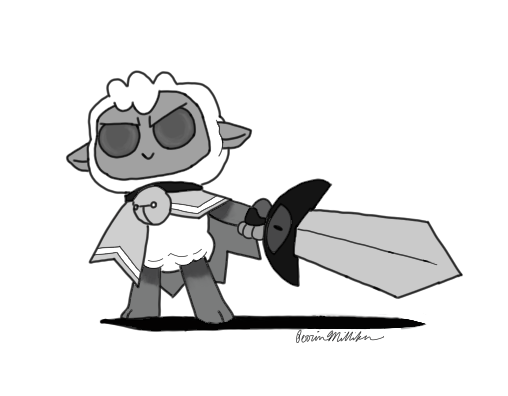The Look: Cult of the Lamb, an experiment in genres
September 16, 2022
 Perrin Milliken
Perrin MillikenIt was difficult to avoid hearing about Cult of the Lamb (2022) while browsing Twitter and other social media circles, and having finally finished the game myself, I can see what the buzz is all about. Cult of the Lamb is a new game by Australian developer Massive Monster and was published by Devolver Digital, a notable company known for their work with Enter the Gungeon and Hotline Miami. It was released August 11 and, in the first week alone, it sold over one million copies. So, what makes Cult of the Lamb so special?
In Cult of the Lamb, you play as The Lamb, a conduit of power for an ancient demon known as “The One Who Waits.” Your objective is to amass a following strong enough to challenge the four bishops of “The Old Faith” and establish your cult as the most powerful in the land. The twist and arguably the game’s main draw is how Cult of the Lamb chooses to meld this tried-and-true demonic cult narrative with the cutesy aesthetic of games such as Animal Crossing. Cult of the Lamb is incredibly successful at combining the two seemingly contradictory styles of cute and creepy, and this alone makes the game worth looking into.
The vision and presentation of Cult of the Lamb is truly phenomenal, and the tone it sets by placing innocent woodland creatures amid such demonic on-goings is communicated with incredible ease. Its presentation has an air of cynicism to it, a commentary perhaps on the lack of aesthetic vision that has gripped most of the gaming industry, challenging stagnation by purposefully combining opposites to create something wholly unique.
The gameplay of Cult of the Lamb reflects this melding of aesthetics by combining elements from rogue-like games, such as Binding of Isaac, and base building games, such as Animal Crossing. If you’re not familiar with rogue-like games, they often orient around combat and involve moving along a path usually called a “run” to see how far you can get until you die, with each run being defined by what kinds of upgrades and abilities you find while trudging through waves of enemies. A lot of your time is spent keeping your cult members happy, feeding them, giving them places to sleep, cleaning up after them and delivering sermons to strengthen their faith. To get materials for maintaining your followers’ happiness and the strength of the cult, you must enter the rogue-like sections of the game in which you battle servants of your demonic enemies and save some little critters along the way to indoctrinate into your cult.
There is a rather subtle poetic element to the way Cult of the Lamb combines two contradictory styles and genres, as its demonic tone can be traced back to rogue-like games such as Binding of Isaac and Hades, while its cute presentation seems to be influenced by base building games such as Animal Crossing or Harvest Moon. And so, it seems that the melding of genres reflects the melding of aesthetic styles, which really shows the fullness of Massive Monster’s vision for this title.
The level of interconnectivity between these two aspects of the game as far as the gameplay goes, however, is one of Cult of the Lamb’s weakest points. While it is true that increasing the faith of your followers in the base building sections allows you to upgrade your combat abilities for the rogue-like sections and that the resources you need to upgrade your base can be found in the rogue-like sections, it often feels as though I am playing two different games when either tending to my flock or battling heretics. Cult of the Lamb tries to find ways to weave these aspects together in satisfying ways, but it often falls short due to the inherent difficulties of combining two seemingly unrelated genres. That’s not to say such a zcombination of genres cannot be done, as we see how Spelunky (2013) was able to combine the platformer and the rogue-like in a satisfying way. I welcome Cult of the Lamb’s vision and creativity in the way it tries to break the mold of both genres and try something new, which is why I am even writing about it at all, but I can’t say that it is entirely successful in carrying out this experiment with perfection.
Despite all this, I did very much enjoy Cult of the Lamb. It is a fun little base builder that’ll keep you engaged for all the roughly 15 hours of gameplay it has to offer, but it is also an exciting rogue-like experience that’ll keep you going back for one more run. The overall aesthetic of the game is a joy to experience, and it is apparent that the developers put everything they had into achieving the unsettling demonic yet cute feel of the world of Cult of the Lamb. If you’re looking to experience a world of cute critters and dangerous demons that oozes charm, then I recommend you give Cult of the Lamb a try.
Cult of the Lamb is currently available on PC, Xbox, PlayStation and Nintendo Switch.

Comments
Before submitting a comment, please review our comment policy. Some key points from the policy: